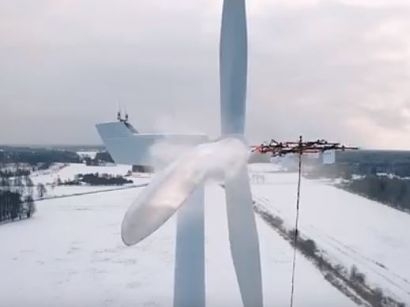
The drone can lift up to 200 kilograms (441 lbs) of weight and is connected to the ground via an electricity cable and a water hose. The electricity cable powers the drone so that it can stay in the air as long as required and the water is pumped from the ground, enabling the drone to deliver plain water, hot water or distilled water. Cleaning solutions and anti-freeze solutions such as hydrophobic coatings can be added to the water. Only non-hazardous and biodegradable chemicals are used.
A truck on the ground provides all the necessary equipment for the cleaning operation, so that there is no need to connect anything to the turbine. The truck also provides a take-off and landing platform for the drone and incorporates or carries an electricity generator to provide power. It also carries the pump for the water and a heater. In the future, Aerones are planning to improve their software so that the drone becomes operable by just one person or even completely autonomous.
The drone also has onboard batteries so that it can land safely in the event of a fault with the cable.
“There are many other applications for the drone” said Janis Putrams, Aerones CEO. “One is firefighting, another is rescue and there are also many sports applications. Right now though we intend to start with cleaning and de-icing wind turbines because we have the technology and we can see the benefits this technology can bring. We think we can bring more safety, more speed and more cost efficiency for wind turbine cleaning and de-icing”.
Aerones is based in Riga, Latvia. The company also produces autonomous flight solutions, automated safety systems and electronics (sensor bus) solutions.
For additional information:

